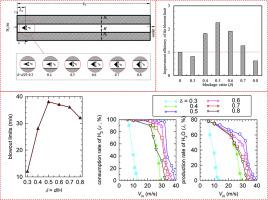International Journal of Hydrogen Energy ( IF 7.2 ) Pub Date : 2020-07-01 , DOI: 10.1016/j.ijhydene.2020.04.113 Minghao Wang , Pengfei Li , Feifei Wang

|
In this study, we numerically investigated the main factors affecting the flame blowout limit of bluff-body micro-combustors with a blockage ratio (δ) varying from 0.3 to 0.8; the combustion performance of these combustors is investigated as well. Measurements from the literature (Fan et al., 2012, Int J Hydrogen Energy, 37, 19,190–19,197) were used to validate the present numerical models. The predicted results are in good agreement with the experimental data, with a relative error of less than 10%. The results show that the blowout limit increases with δ in a non-monotonic manner. The establishment of a low-velocity recirculation behind the bluff body and recirculation of heat and key radicals help increase the flame blowout limit, whereas the stretching of reaction zones has an unfavorable effect. In contrast, heat loss contributes negligibly to the difference between the blowout limits in the micro-combustors for different values of δ. An extra pressure loss or initial power input is required to improve the blowout limits. An available size of the in-built bluff body should be carefully selected to maximize its efficiency and to considerably improve the blowout limit; however, this should be realized while ensuring a low cost of pressure loss when designing a micro-combustor. In general, δ = 0.5 is relatively optimal and recommended for the straight combustion channel discussed herein.
中文翻译:

吹气极限对钝体微型燃烧器的流动结构,传热和压力损失的影响
在本研究中,我们通过数值方法研究了阻滞率(δ)在0.3到0.8之间变化的钝体微燃烧器火焰爆燃极限的主要因素。还研究了这些燃烧器的燃烧性能。来自文献的测量值(Fan等人,2012,Int J Hydrogen Energy,37,19,190–19,197)被用于验证当前的数值模型。预测结果与实验数据吻合较好,相对误差小于10%。结果表明,井喷极限随δ增加以非单调的方式。在非流线形体后面建立低速循环以及热量和关键自由基的循环有助于增加火焰的吹出极限,而反应区的拉伸则有不利的影响。相反,对于不同的δ值,热损失对微型燃烧器中爆燃极限之间的差异的影响可忽略不计。需要额外的压力损失或初始功率输入以改善井喷极限。应仔细选择内置阻流体的可用尺寸,以最大程度地提高效率并显着提高井喷极限;然而,这应该在设计微型燃烧器的同时确保较低的压力损失成本的同时实现。通常,δ = 0.5是相对最佳的,建议用于此处讨论的直线燃烧通道。


























 京公网安备 11010802027423号
京公网安备 11010802027423号